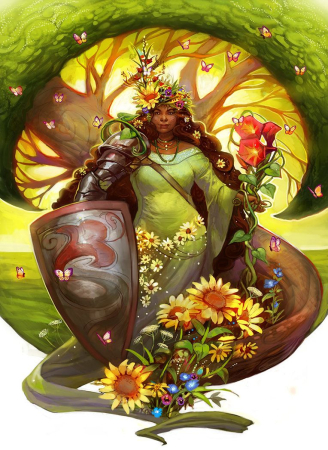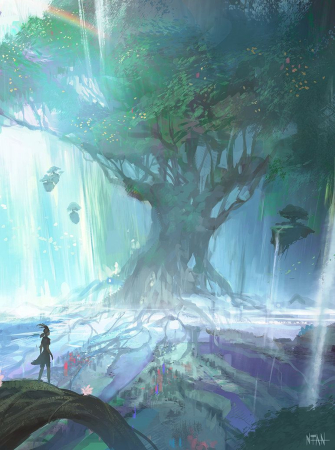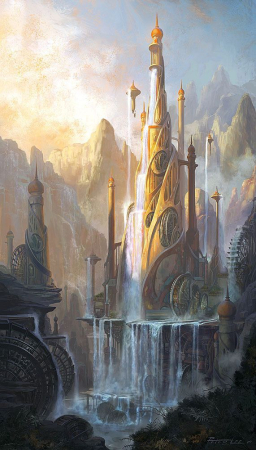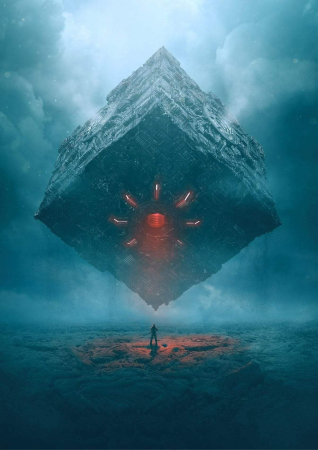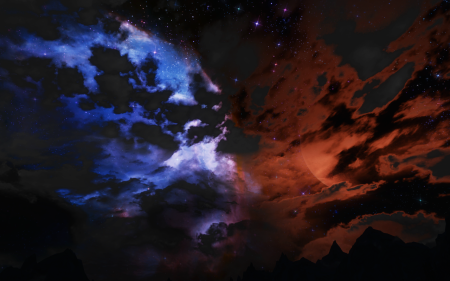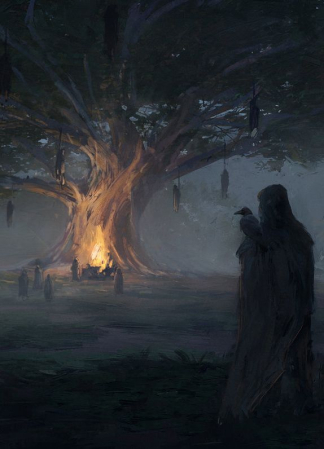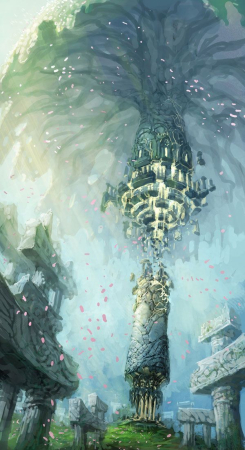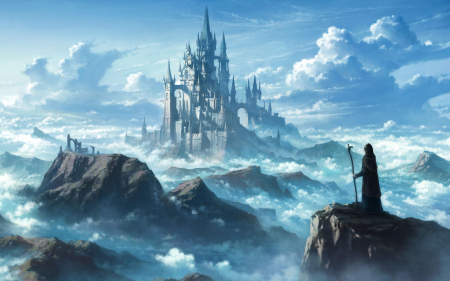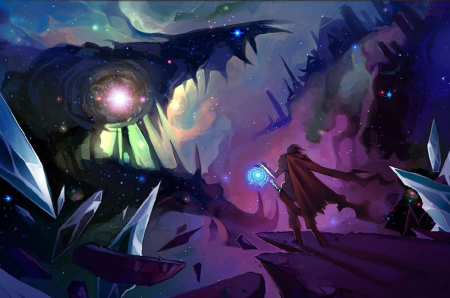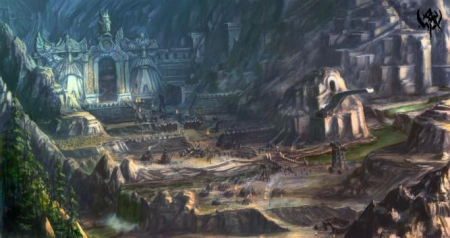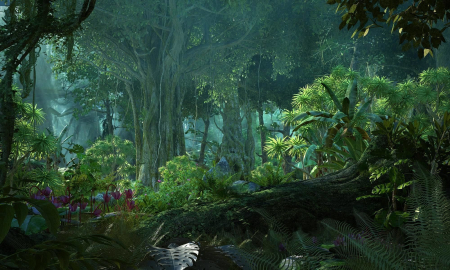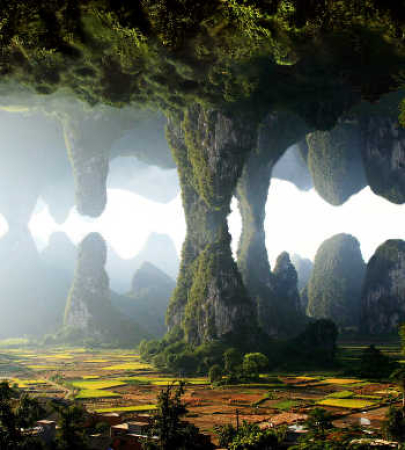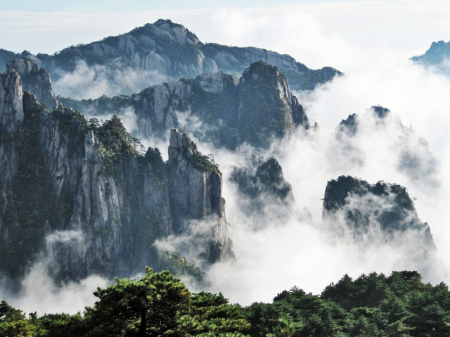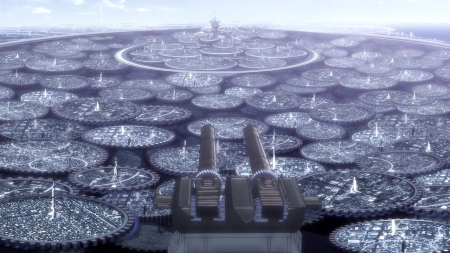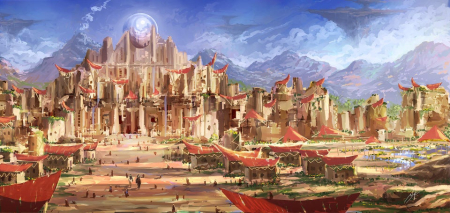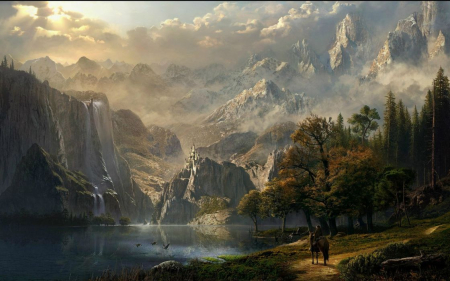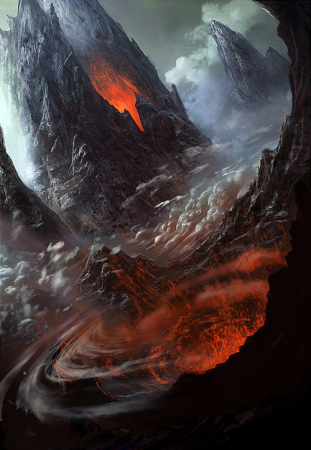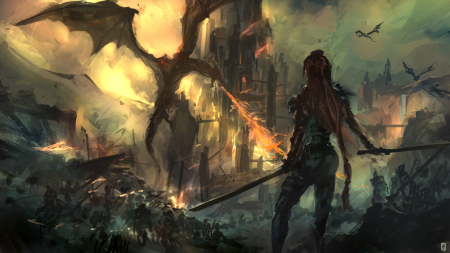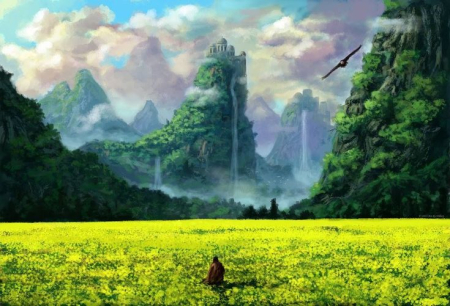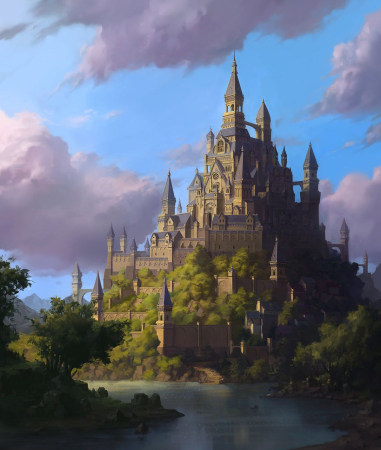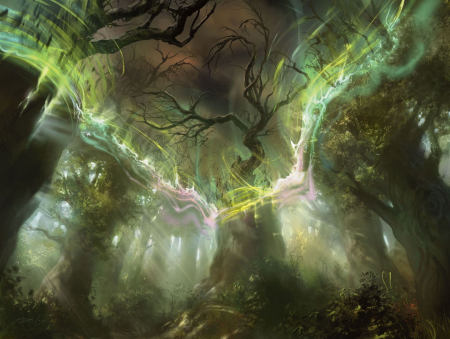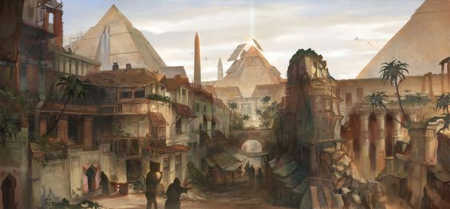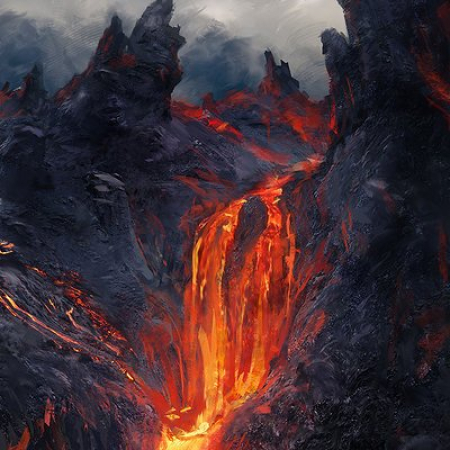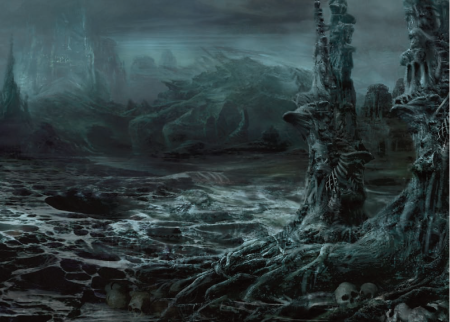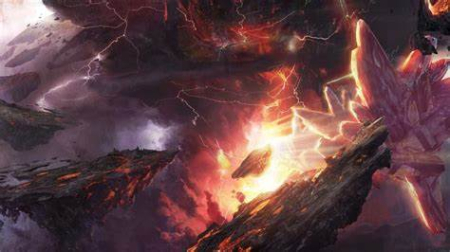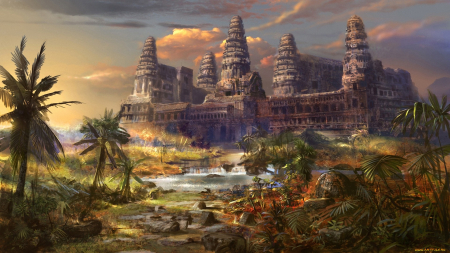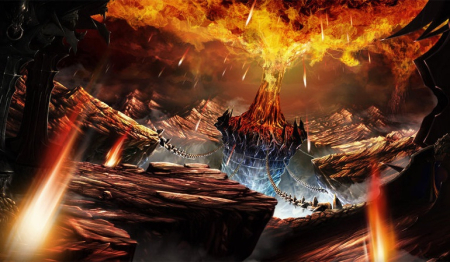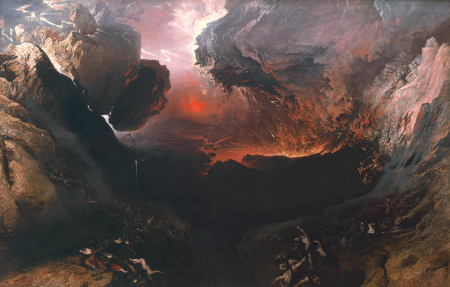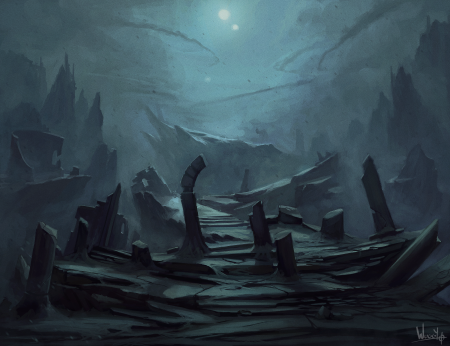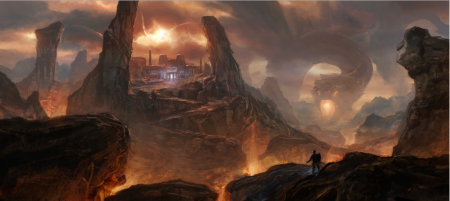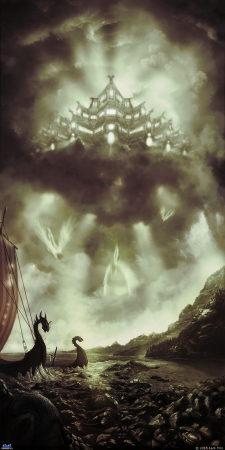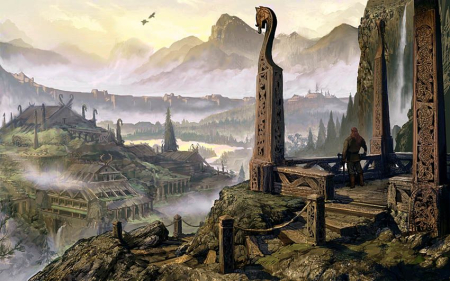Ankh'hera, the Desert Jewel
Ankh'hera, the thriving desert theocratic diarchy-kingdom set beside the River Ississa and Bijeauine delta that has existed since the Arcanum Era (over 2000 years ago). The homeland of the great Tabaxi 'Prides', and their famous ruler, the The Mystras of Ankh'hera, the chosen Oracle of Pansophia and great divination archmage. Co-existing with a contingent group of beast-folk, most prominently the desert Gnollpacks, lead by the warrior-matriarch known as the Reignar of the Mangehearts. Due to its coastal access from the river delta, its rich and fertile grounds seasonally providing great amounts of crops each year, many people have thrived under this land. This kingdom has risen and fallen many times, but one certainty is that the Mystra has always remained in power, gifted with the universal truths bestowed unto them by previous Mystras before them since the Arcanum Era, and mastered the secrets gifted by Pansophia, the Knowing Mistress. The land is renowned for its exotic culture, spices, perfumes, rich and colourful art, its ancient and scattered ruins of the Old Kingdom of Ankh'hera... though it has faced its own number of hardships and tragedies over the years. Though this realm, its capital, has become the site of a new renaissance of thought and creativity, a meeting of the past and the future - as the capital takes its new form by the Ississa River and its old sandstone palaces and great pyramid, becoming part of a new industrious era that makes it seem like a 'living city of moving stone and bridges'.
The capital city of Ankh'ara wears its Tabaxi heritage proudly on every building, tower and rooftop. As one of the oldest cultures and largest cities on the Aetha'Shar continent, Ankh'ara considers itself the founding seat of civilisation in the chaotic world. Thanks to both the Ankh'hera Diarchy and the progressive spirit of the Tabaxi people, Ankh'ara has become a relatively safe place to live. However, Ankh'hera does not reign supreme within Aetha'Shar or even its immediate vicinity. War and drought threaten them constantly with the draconic Ozon'Siiari Sultanate of the east, and the desert barbarians from the Vasharan and Duat'tera Deserts, remaining a considerable threat to the Ankh'heran way of life.
The present government of Ankh'hera is comprised of differing branches, each with a unique influence. The Mystrasi must share power with strict government entities that have been around since the founding of their kingdom. The structure of government is settled between a diarchy, a rule of two, one of theocratic magocracy of the Tabaxi & a tribal chiefdom of the Gnolls. Each community looks primarily to its own ruler for leadership and guidance, but the two have worked amicably together for centuries for the sake of protecting their people. MYSTRASI & REIGNAR At the top of political power sits the Mystrasi and the Reignar. The co-dependent dual 'monarchs', a Tabaxi Oracle and a Gnoll Matriarch between the central Pridelands and of the southern Savashan subcontinent. The Mystrasi enjoys expanded ruling power thanks to political manoeuvring by their prior Mystrasi chosen, and her position as the theocratic leader of state from the divine guidance of Pansophia. The Mystrasi's power of foresight and peering into the past, although limited to an extent, is not to serve themselves but to serve the people and maintaining power among other nations. Since the first Mystrasi, their role was and always will be the idealistic 'sage-ruler', bridging the divide between the heavens and the earth, and acting with the interest of the people. For their lives are always on the knives edge to disorder and chaos; through the Mystrasi, they are guided and kept in order. However, the Mystrasi is not bound nor elected, but chosen, believed to be the mortal avatar of Pansophia. After the Mystrasi dies, the Prident takes over as regent until the next avatar is chosen and found amongst the commonfolk - usually appearing from one of the Rivers with great powers of divination. Declarations made by the Mystrasi from the Oracle Palace becomes law almost by default, although the Oracle Arbiters retain the ability to counter anything brash or foolish that violates the Ankh'hera City Charter, or the Laws of Pansophia. Whilst their decrees are likened to the words of the Gods, the practicality of such measures are optimistic at best, and incredulous at worst - their word is taken seriously, though the council and even the Mystrasi are both mortal, and thus can only act within the scope of reason that the Diarchy can muster with the aid, and consent, of the people. The Reignar remains appointed through martial prowess and success through the dominance of the Gnoll packs - they enjoy political and military power, whilst also governing from afar in the Gnoll capital of Ban Hyamavra. However, Gnolls only respect their leader if they have won the title through bloodshed and through domination of all other clans seeking a claim to the title of Reignar. By right, the Reignar can only assume power by demonstrating that they have power - only then can they wield such power for the good of their people; promises can often be lies, only actions can muster a grain of truth. Gnolls fight because it is their nature, to go against it is to go against their nature. After the bloody affair, a dynasty rises between the many heirs, but follows an endogamous and matrilineal primogeniture - inheritance can only come from a noble family, and follows the rule of the firstborn daughter of the previous Reignar. They can only stay in power if their rule is respected by might, anyone is capable of challenging the potential Reignar-to-be, but if they refuse to give up the title to the challengers, they go to civil war amongst their kin until one side has been defeated or enslaved. One must be willing to put everything on the line to achieve greatness, their riches, their pride, their family, their home... Such is the way of the Gnolls. Declarations made by the Reignar from Ban Hyamavra becomes law to all the Gnolls by default, however, this is met with less challenge from the Gnoll Pack Lords, as Gnoll tradition dictates that the mighty rule over the weak - but the Oracle Arbiters retain the ability to counter anything brash or foolish that violates the Ankh'hera City Charter. The Gnolls recognise the power of the gods and wish to follow this path to be recognised as civilised beings rather than brutish barbarians descended with demonic blood. But the two sides act as a counter-balance - the followers of the Mystrasi representing the development of civilisation of magic, whereas the followers of the Reignar represent the natural world, the wilderness and even the dead. One Tabaxi noble from each of the Great Prides & one Gnoll Pack Lord sits on an advisory democratic council named the Court of the Great Sphinx. The Mystrasi & Reignar cannot dismiss the Court of the Great Sphinx but also they do not need to respect their input. However, politics dictate that they at least listen to arguments presented as the Great Prides have substantial political power and representation in Ankh'hera, and the Pack-Lords hold substantial military power & resources in Savasha. Because the Mystrasi and Reignar cannot regulate every aspect of the city and kingdom, or the differences between their people, nor do they want to, a set of magistrates divide responsibilities between each respective group. The purpose of such a council is two-fold, a quid-pro-quo. The council links with the divine whims of the gods through the eye of the Mystrasi, and seeks to spread the word and will that would seek to keep order and unite the kingdom - whilst they maintain their power, prowess and the voice of the people from their own respective domains, the council ensures that the Mystrasi continues the prosperity of the land through the graces of the gods good wills. Living in the great palace with the Mystrasi and their honour guard is a powerful figurehead and commander of the Androsi Claws, known as the Prident. The Prident is considered the second most powerful individual in the city, under the Reignar and Mystrasi, and is the only one who can begin the process of removing a corrupt ruler, namely the Mystrasi. If the whims of the Mystrasi produce an air of tyrannical rule where power concentrates solely on one individual, perhaps to the growing megalomania brought about by gods given gifts... it is within their power to subdue such a person before the realm falls into disorder and chaos. Such a duty can only be done by one that follows the true path, and prioritises the order of the realm first and foremost. However, they fall between a fine line as the ideological protector of the Mystrasi, and the defender of precious unity amongst the people. Calling the Androsi Claws to evict a monarchy places the Court of the Great Sphinx in much higher standing according to the Ankh'hera City Charter. This act has never been executed in over 1000 years of its existence. Journeying and following the mobile court of the Reignar, are her elite Dowry Guard, who are usually chosen firstborn sons from each Pack Lord that serve to protect their leader first and their pack second. This also serves to keep any challengers in line by keeping their children effectively as respected hostages & the assurance of a noble bloodline. Following the Court of the Fanged are the Reignars prized councillors, loyal chiefs and advisors, known as the Amama - who are the highest mortuary priests of the Gnoll ancestors, and speak with the spirit of Old Hyana. They speak for the Gnoll Packs and tribes, outside of the influence of the current Pack Lords and represent the historic spiritual line of ancestors that hold the pure blood of Hyana and not the corrupt lines of Gnolls cursed with demonic blood. The Reignar is inclined to listen to the Amama, for they speak as the messengers of the pure-blooded ancestors and hold prized knowledge of the past that no ruler could ignore. Much as the Mystrasi is the intrinsic link to the gods, the Amama are the Reignar's intrinsic link to their heroic and pure ancestors. It is through their ancestors that they believe that they bless the rule of the Reignar, and allow her to continue to reign until the time comes when the blood must be spilt in order to remain pure. MAGISTRATES When a new Mystrasi or Reignar takes the seat of power, they appoint several magistrates within the Diarchy to delegate responsibilities, as well as becoming members of the Courts. No one exactly knows what the magistrates or their staff do, but most Tabaxi & Gnolls suspect they enjoy wasting time and money. So say the pessimistic. Yet they are essential to the running of government. They are usually appointed by influences of noble families, or through prominence within the Church of Pansophia, or, in the case of Gnoll magistrates, the worship of Hyana and the close proximity and relationship to the old ancestors. The most well-known (and hated) magistrate is the Magistrate of Commerce. For the Mystrasi, the magistrates appointed are chosen through the rigorous path of meritocracy, and also to give great responsibilities to the Pride Lords that fit their station. Each of the Prides, the Grasses, the Winds and the Rivers, present candidates that they deem and judge worthy of the role through experience, age or talents deemed useful for government - but overall it is the decision of the Mystrasi to choose these individuals to help lead their diarchy effectively and selflessly. One cannot become a Magistrate without displaying noteworthy talent - literate and well read, can recite over 5000 words in six-differing styles of writing, understand fair and lawful actions and commit themselves to the gods. But, the only fixed and undisputed stations are those of Oluwa (Leader), the patriarchs of each of the Great Prides - that represent each of their clans as a whole. These stations remain hereditary, as to appease the nobility of Ankh'hera and involve the voices of each of the Prides of Ankh'herans in the Court of the Great Sphinx. However, such positions make them responsible for their own clans and their actions - and should political infighting be present, and affect all others for instance, by crimes of corruption or treason, then their family will be stripped of honours and a new favourable candidate for the position of Oluwa will be given at the discretion of the Mystrasi from within their respective Pride. Corruption, complacency and carelessness are uprooted entirely.
Those that belong in the first half of the Diarchy, are ruled by the Mystrasi & fall under the purview of the Court of the Great Sphinx - that answered to the whims and dictates of Pansophia. Most of Tabaxi society are worshippers of Pansophia, the erudite goddess of knowledge, prophecy and truth. Protecting the Tabaxi populace within the Pridelands are the noble-appointed families of the three groups of Tabaxi society, the Oluwas. Each Oluwa represents the patriarch of their respective noble family, and leader of the vassal houses of the three collective groups of society: the Pride of the Tall Grasses, the Pride of the Howling Winds & the Pride of the Rejuvenating Rivers. Originally, these Prides were the fundamental groups and castes of society in ancient Ankh'hera, but in modern times they have become more egalitarian and inclusive of other peoples - rather than closed ethnically-cultural groups of Tabaxi, now represent the peoples of the different 'gifted' circles of life within the Pridelands. Each Pride operate under a meritocratic bureaucracy, where those with the most skill and natural favourable worship of Pansophia (whether public, true or private, is unnecessary, only that they pay due worship or veneration), rise to the highest ranks - the highest rank of the most experienced and talented rise to become patriarchs of lesser Prides. If recognised, these patriarchs are capable of beginning their own powerful leading houses within the Prides. These Prides in turn answer to the most respected group among their number, who become the Oluwa. Those who show their faith outside of the Prides, rising as prominent individuals belonging to the academia and religious temples are those high-priests and mages who have attained the favour of the people, through skill, wit, learning, achievements and power-plays - the rulers of the territories (Viziers). Beneath the Great Viziers, are the Pride Lords, of whom represent the larger feudal-based military and more secular rulers that worship underneath the Church of Pansophia - their highest rank and warrior is known as the Prident. Beneath each Pride Lord, are the three groups that form the structure of Tabaxi society: the Pride of Grasses, the Pride of Winds and the Pride of the River. The second half of the Diarchy is the tribal kingdom of the Reignarate, led by the Great Reignar, a single and all powerful individual matriarch. Of whom, the Reignarate follows a hunter-based feudalistic society and setting. They respect family, having strong bonds between one another forged through mutual co-operation and competitiveness, reinforced through honoured traditions of filial piety and respect for their ancestors. Each group holds on to hunting ground rites and gifts of rainfall grounds between agreed territories, and selections of hoards and first kills. The strongest, biggest and meanest rise to the highest ranks, as their society demands competition for survival in order for the whole to survive. The strong become leaders and hope to pass on their wisdom and bloodline to their heirs in a continuous passage of strength, meanwhile the weak become the Reignars responsibility and are set to serve the strong in all other matters and affairs. Under the Great Reignar, are the lesser Reignars known as Aardaks (Pack Lords), the matriarchs of the different territories between Savasha and Vashara. Aardaks gain rule of their clan through competitions of strength, battle and hunting, as well as holding reputations from their ancestral forebears from their maternal line. The daughters of Aardark's remain alongside the other females of the clan, meanwhile the sons are trained until they reach their prime age at puberty and are forced out of their clan. From there, the young males join into other Aardak clans as the lowest males of the clan, subordinate to the dominant females, the native males and foreign males that came before them... but become the most favoured for the rulers - keeping their bloodlines more diverse and pure, though this does not deter the other males of the clan. The Pack Lords fall underneath the Reignars, as the competing 'leading males' seeking affections for their great matriarchal leaders - then comes the dynamic, social and broad Great Packs.
The primary faith is Pansophian, as well as the old remnants of Hyana - with the pure-blooded Gnolls that have inherited and partitioned outlands of the Great Vasharan Desert and around the great river delta. What is peculiar in the case of other faiths, is that they espouse a fellowship of higher and greater learning and the pursuits of knowledge. Each one that venerates Pansophia is a person who seeks to learn, preserve and discover knowledge in new and old studies of whatever one wishes to desire or improve upon to make society a greater and more prosperous place for its people. This faithful following has led to a constant and undoubted advance in society, to widespread literacy, greater reading circles and places of study - colleges, universities and great libraries fill the land with all sorts of knowledge to the benefit of Ankh'hera. It is part of their history, as their civilisation was believed to have been guided and nurtured by the hands of the Great Sphinxes, the now mythical patrons of Old Ankh'hera that sought to guide the creations of the Gods and follow their will. That is, until the great fall and taint of power brought forth by the abuse of magic - where mortals in the Age of Arcanum believed themselves better and greater than the gods. The Sphinxes fell, and influenced the rise of the Lamias, the manipulative beings that spread ignorance and lies, enamoring the foolish to selfishly pursue their own indulgent fantasies and base desires... only empowering the power of a Demon Lord and allowing demons to fester within their ancient land. The wars between the Divines and these Demons left their lands as broken and desolate deserts - and only through the guidance of the last Sphinxes was Ankh'hera capable of surviving the Great Cataclysm and preserve the Pridelands. Their teachings and influences still reside to this day through Ankh'hera's leader, the Mystrasi, the chosen of the Sphinxes - of whom have disappeared after the Great Cataclysm. The lessons they left to the Chosen of Pansophia are still evident to this day. These teachings and maintenance of the ambitions of mortals has led to a prominent portion of the population becoming talented arcanists & scholars. Thus, faith in Ankh'hera is a means of progress, and a necessity to preserve order and law. The faith is resolved to be largely towards faith in the greater powers of Vashara, under the traditional worship of the Tabaxi - and predominantly other powers such as Pelor the Dawnfather, Null the Unborn Godling, the Raven Queen, Melora the Wildmother, and Erathis the Lawbearer. The Mystrasi represents the leading figure of the Ankh'heran Church of Pansophia, thus the leading virtue of all one can learn, stay truthful & combat ignorance in the world. Underneath the Mystrasi are the Great Vizier and the lesser Viziers of the country, coupled as the leading elite class. They guide the masses and control the ebb and flow of information within the cities and the lands of Vashara through the Enlightened Path. Their goals are to invest in the development of knowledge and the preservation of wisdom and magic, to ensure its moral and ethical use for the greater good and to guide those that seek knowledge to use it carefully. They develop and practice new magics and create magical items with their church, as a dedication of their faith, the refinement of their spirit and for the betterment of the world. They do not wish to repeat the great errors and hubris that the ancient magocracies had committed that led to the Great Cataclysm and the release of the Diabolical Ones. However, a point of controversy remains within their religion - in that they, as the Divines followers, believe they are gifted with free-will and can determine their own fates. But, those that seek to undermine their society are known as the Fate-Touched, those corrupt souls supposedly born without free-will. They are those who have lives pre-determined by dark and nefarious powers, working against the will of the Divines and thus all those who are free. Those deemed to have no free will, therefore have no right to the same equality as the people of Ankh'hera. Throughout history, especially since the Great Cataclysm, there have been many who have been coined under the term, the 'Fate-Touched'. These are all those who brought an end to the peace and prosperity of the world in the ancient era, the followers of the Diabolical Ones and their children and all those that worked against Ankh'hera in the old eras. They committed the great sin of allowing the return of the Dark Gods, and forced the hand of the gods that brought about the desertification of the continent of Aetha'Shar from a once vibrant and green utopia... and their punishment is to never allow them peace, for they offered none and devastated their once great land. Those predominantly vilified as the Fate-Touched are those with demonic and dark bloodlines: be that of Gnolls who are believed to follow Yeenoghu, the Feral Tiefling desert nomads known as the Mek'rodemzai from the ancient state of Mekrozadh, or even wandering bands of Minotaur that wish the return of Baphomet. Other lineages have been marked and deemed as being Fate-Touched in the past for more obscure reasons.
Ankh'heran society is a melting pot of different, traditional and old cultures and beliefs and practices that is exotic and unusual to those from differing kingdoms. The Ankh'herans respect their dead in a public fashion and believe in multiple faiths that act through appearances within their temples and are divined by the Viziers. The people often fall into one of the three great collective Prides based on their place of birth, or familial relations - those who are born within the coastlines or around the desert borders belong to the Pride of Howling Winds. Holding the most militaristic and versatile groups, and often are the most nomadic of the three Prides. Those that tend to follow a more humble agrarian lifestyle, become fishermen or merchants belong to the Pride of Rejuvenating Rivers, the majority of which are those primarily born close to the many winding rivers of the Pridelands. Lastly, the Pride of Tall Grasses - they tend to be those who are born within the wilderness and savannah surrounding and encompassing the Pridelands, tending to reside outside of urban regions, and form the largest, oldest and most populous collective of the Prides. They are less interested in progress and are content with their rustic and rural backgrounds. In this society, the means to which you advance in this region is primarily by two things: what you know, and who you know. Learning and adapting is a continuous means in Ankh'hera, as ignorance & laziness is looked down upon. Being learned and literate are customary to the people, and to help them pursue their goals to the best of their ability - and to protect themselves from the dangers of the desert.
Largely populated by the Tabaxi, filling around 70% of the population. The second largest population is the Hyanan Gnolls, making up 10% of the population. There are numerous other races that fill the land here: Humans (6%), Tortle (4%), Dragonborn (2%), Lizardfolk (7%), and the other 1% filled by a multitude of other races.
Ankh'hera benefits from the protection of three military organisations. Each military group focuses effort on different areas, interacts with the city government in unique ways and is important in providing balance to the political powers in the Ankh'heran Diarchy. THE ANDROSI CLAWS The Androsi Claws are an elite force of 50 mage knights dedicated to the defence of the skies, waters and deserts of the Ankheran Diarchy. The commander of the Androsi Claws reports directly to the Prident and does not answer to any other leadership position in Ankh'hera. However, when a new ruler takes the position of Mystrasi, the Androsi Claws make a display of riding to the capital and pledging loyalty as their ancestors did before them. To qualify to be named the Prident, an Androsi Claw officer must be a pureblood Tabaxi and must endure the trials set forth by the ancient Sphinxes in the Androgyne Mountains. THE ANKHERAN GUARD The 1200 soldiers that make up the Ankh'heran Guard serve the city first and the Church of Pansophia second. Working closely with the Mystrasi, the Ankh'heran Guard act most often as the police force but will turn into a military operation when the city is threatened. Possessing a long and proud history augmented by the Church of Pansophia, the guard counts among its highest officers clerics, paladins and priests almost all of whom are of Tabaxi descent. It is the duty of the Ankh'heran Guard's commanding officer to appoint a new Prident of the Androsi Claw when the previous Prident passes or retires.
...
(To be revised**) The Gnoll Packs were the original inhabitants of the southern lands of Savasha around Ankh'hera, working against the ancient Prides of the Tabaxi - in ancient times the Gnolls were not the foul and primal demonic-blooded creatures they have been seen to be as now. Their bloodlines were traced to a more benevolent being of the Gnoll's, sometimes referred to as the Hyana the Surrogate Huntress, a petty nature goddess in comparison to the other Divinities. The Tabaxi were denizens of central regions of Aetha'Shar, a thriving jungle landscape filled with great wilderness and exotic beasts. They were guided and taught writing and literature by the Great Sphinxes, and eventually the power of magic. The original Prides followed in the footsteps of the Androsphinxes, taught to be true and good hunters & keepers of law; seeking to conquer and spread their lands against a rising human population in the east, known as the Mekrozadh Magocracy. Others prospered within the eastern-central regions, guided by the Gynosphinxes, who taught them the ways of truth, reason and philosophy, to think before they acted unlike the bold and arrogant Andropshinxes. The lands of Aetha'Shar were once abundant in a great many spirits and beings of nature - especially the Horned King, Asterion, the Great Bull, and father of the Minotaur. They had no great cities to their name and stuck to the wilderness; he maintained the balance of nature, and warned those who sought to bend nature to their will. Yet, he grew curious to the actions of the Mekrozadh, inquisitive of their prominence of magic, bewildered by their magic. Hyana was distrustful, but the Mekrozadh mages afflicted the Gnolls with a dire curse - hiding their affiliations with the dark demonic powers of the Abyss. It is said, that Hyana was led to hunt the dark apparition that began to appear and destroy the lands and jungles of Savasha and Vashara - only to glimpse upon the madenning Dark god, Tharizdun. His machinations and destruction sent Hyana into a bloody rage, one that was merciless and brutal... when the madness faded and tasting demonic blood, she felt a hunger rise in her belly. Slowly, but surely, Hyana encroached over the lands of Asterion - who was bewildered and bewitched by the Mekrozadh mages, tainting the power of the god. Hyana was furious, and began a slaughter of Asterion's children - to the point that Asterion was thrown from his stupour and saw the trick that had been played upon him. The two beings fought against one another - the dark afflictions affecting them, until others of the Primordial Green banished them into the Abyss, for which they transformed into their dark forms, Yeenoghu and Baphomet. The Gnolls to that point had favoured scavenging, hunting and proving themselves to their family and clan - that is until Yeenoghudefeated and consumed Hyana's essence and became the Demon Prince of Savagery. A wave of bloodthirsty and savagery overwhelmed many of the Gnolls that followed in Yeenoghu's path, waging war with the Tabaxi. The Tabaxi of Ankh'hera had faced their own trials, as another demonic entity corrupted their once great patrons - the Sphinxes. Leading them down a path that was in denial of the will of the Divines - Graz'zt the Dark Prince had allured one Sphinx to believe that their purpose was worthy of veneration, much like the gods. That they should not be in service to the mortals, but the mortals to him. The dark powers that enveloped the Betrayer gave rise to a corrupted and manipulative race known as the Lamias, who toyed and indulged in dark pleasures across Aetha'Shar. Enticing new followers to engage in rampant and selfish destruction and the twisted fulfillment of hidden and evil desires. What was once known as the great old-civilisations of the Savashan Kingdoms - an old practice to help the aid of their Gnoll clans practised petty necromancy, giving rise to the Witherlings, only in times where the clans needed aid in times of famine, hunger and drought... forming gravesites and protected 'scavenger hoards', otherwise remembered as the Bone Cairns/ Dune Graves. They bargained and aided beasts like manticores and perytons within the badlands for aid, forming true relationships with them and beasts - they had no need for metalwork but were known as prominent scavengers, petty illusionists and shamans. They revered creatures like the Scorpion, the Rats, the Great Worms, the Crocodiles, the Jackal, the Hyena vehemently - almost like 'household celestials' of a kind. Many practised the art of 'breaking the spirit', becoming Tantekurashs or forming bands of 'Kryshentals' (Savage Souls) after torturous works within their bands. They had perfected the art of it, to make others think in their ways. It was only by the incursion and defilement made by Yeenoghu that these practices were corrupted - Witherling's became infused with abyssal energies in their creation, meanwhile, the pure-blooded Gnoll's still retained and remembered their old tales which could make out 'living undead' that retained their spirits but without the need for food or water, contributing to the survival of the clan, maintained and respected by their matriarchal-elders. This sowed the chaos amongst the land as Gnoll's fought Gnoll's, the spiritually and pure-blooded, against the ravenous hordes of hungry barbaric creatures swayed by promises of power and a curse of hunger - giving rise to the prominence of the nomadic tribes of Tabaxi, led by a prophetess that wandered across the lands. The Tabaxi seemingly were guided under the machinations of Avandra the Change-Bringer, of Pansophia, the Knowing Mistressand Shelúne, the Moonweaver - they had faced great trials and tribulations amongst the wild regions; but gave rise to new architecture and culture under the guidance of the Sphinxes that made their home in this region. Particularly, the prominence of the Gynosphinxes (females) that fought off against the Androsphinxes (males) - they worked to protect the nomadic tribes of Tabaxi, and brought them towards enlightenment in these times - teaching them in modes of wisdom, intellectual pursuits, drawn by the Tabaxi's love of stories, adventure and knowledge... it was through these works that the Tabaxi eventually found among them a chosen one that became trained and chosen by the old Sphinxes during their rise of power - to rise against the hedonistic mentions of the diabolical clans under the Lamias (worshippers of Graz'zt - Norasinghe). These two ancient debacles brought into a conflict between the Gnoll lands - there were the enlightened sphinx-lands of the north, and the lamia-lands of the east; seemingly connected by the rivers and lakes that coursed through the land of 'Savasha, the Green Crescent Peninsula'. It was after the Divergence where the eventual fall of the Lamia-nobles and Sphinxes drew the Gnolls to greater power but also drove them into hiding - protected in a strange sanctuary that had been competed over and destroyed and rebuilt in different fashions for Lamias perverse-sexuality and the sphinxes pursuit of knowledge: Ankh'hera. The legacy left after the Divergence was fought over by competing factions between those once loyal to Lamias, and those to the sphinxes - but also was the birth-right of the Gnolls, their ancestral homeland where they had buried their dead and built by the river lands to grow prosperous and old; their respected and old shrine of their now consumed primeval god, seek to preserve their legacy (the Savashi/ Gnorihman). The Lamias left their taint with the ingratiated slavers of the southern wastes and savannah, of Alma-Faeince, a slavers den of Tabaxi and Gnolls, (Mardyakhor) taking both their kin - hoarding great pleasures and drugs procured in their 'plantations' in the greener regions around the Dead Lakes; the Sphinxes seemed to rule among lone mountains amongst the north, with a divide in western and eastern regions between the Gynosphinxes and Androsphinxes; though they eventually united amongst one another, coming to be Prides and Guides (Synods) to unite against the threats of their lands, practising the ways of good and truth and intellectual pursuits that put them at odds with their enemies, and they succeeded further through their own civilised-advancement. The strange evolution that came to be after this, was a mixture of arcane-divine magics that became ingrained in their culture - the protection and pursuit to knowledge and truth, forming champions worthy of the Sphinxes Trials - the Mystras, the prophetess trained and garnered by the Gynosphinxes of the North-West - and the Prident, the holier champion of the Androsphinxes that manifest their great roars, power of voice and their strength. Many had been swayed into notion by the debauchery felt by the Lamias, and many conflicts resulted between the guardians of the north and the petty rulers to the south vying for power... but all were eventually threatened by the Curse implemented during the Dark Ages by the spread of the belief of Yeenoghu, the all-consumer, the one that desired the empowerment of the Gnolls, in a way. But the Reignar, the true purebloods sought to restore the power of the Gnolls in their traditional ways, but had to match the growth and progress of the Tabaxi... and in their need for survival, the Reignar promised themselves to aid the Androsphinxes, and even adopted the rules and wills of the Prides and their Prident... their use of the Witherlings gave them the advantage and match they needed to devastate and conquer the lands of the Lamias. However, the issue became the prominent spread of the 'mind-numbing' drug and psychotic consumables procured in the south, and its great-tradition of slavery and slave armies brought about by the corrupted Tantekurash lords that united together. Ankh'hera became the central heart towards the progress of the 'civilised' groups of Savasha - and the revival of the Gnoll traditions of the past, and the break-throughs of the arcane works of the Tabaxi. Towers rose, temples were erected, and they preserved the archives and secrets of the Sphinxes - held together by an archaic order of Ioun, the Cobalt Soul. In response to this came to be centres of healing, fighting the traumatic attempts of the Lamia's legacy and slavers - healing the addling of the mind, and the plagues brought about unknowingly by Yeenoghu, and the abyssal corruption of the lands to the south. A land filled with riddles, hidden temples of the Sphinxes that have laid abandoned and buried in the sands, grave-robbers and thieves of lost Gnoll burial-grounds, barbaric nomads and slavers, great sand worms that consume all those lost and 'dreaming' in the desert, the great fertile cut of the river delta; the prophetic mountains where the stunning Idol Tableau's reside. With ancient curses, old families of Gnolls and Tabaxi Prides, the works and tragedies of old Mystras and Pridents - the legends of the labours of the Reignar across the realm; the tyranny ruled by the Lamias. The lost spirits and undeath spread through the Witherlings and 'Spirit Witherlings'....
GOVERNMENT & POLITICS
The present government of Ankh'hera is comprised of differing branches, each with a unique influence. The Mystrasi must share power with strict government entities that have been around since the founding of their kingdom. The structure of government is settled between a diarchy, a rule of two, one of theocratic magocracy of the Tabaxi & a tribal chiefdom of the Gnolls. Each community looks primarily to its own ruler for leadership and guidance, but the two have worked amicably together for centuries for the sake of protecting their people. MYSTRASI & REIGNAR At the top of political power sits the Mystrasi and the Reignar. The co-dependent dual 'monarchs', a Tabaxi Oracle and a Gnoll Matriarch between the central Pridelands and of the southern Savashan subcontinent. The Mystrasi enjoys expanded ruling power thanks to political manoeuvring by their prior Mystrasi chosen, and her position as the theocratic leader of state from the divine guidance of Pansophia. The Mystrasi's power of foresight and peering into the past, although limited to an extent, is not to serve themselves but to serve the people and maintaining power among other nations. Since the first Mystrasi, their role was and always will be the idealistic 'sage-ruler', bridging the divide between the heavens and the earth, and acting with the interest of the people. For their lives are always on the knives edge to disorder and chaos; through the Mystrasi, they are guided and kept in order. However, the Mystrasi is not bound nor elected, but chosen, believed to be the mortal avatar of Pansophia. After the Mystrasi dies, the Prident takes over as regent until the next avatar is chosen and found amongst the commonfolk - usually appearing from one of the Rivers with great powers of divination. Declarations made by the Mystrasi from the Oracle Palace becomes law almost by default, although the Oracle Arbiters retain the ability to counter anything brash or foolish that violates the Ankh'hera City Charter, or the Laws of Pansophia. Whilst their decrees are likened to the words of the Gods, the practicality of such measures are optimistic at best, and incredulous at worst - their word is taken seriously, though the council and even the Mystrasi are both mortal, and thus can only act within the scope of reason that the Diarchy can muster with the aid, and consent, of the people. The Reignar remains appointed through martial prowess and success through the dominance of the Gnoll packs - they enjoy political and military power, whilst also governing from afar in the Gnoll capital of Ban Hyamavra. However, Gnolls only respect their leader if they have won the title through bloodshed and through domination of all other clans seeking a claim to the title of Reignar. By right, the Reignar can only assume power by demonstrating that they have power - only then can they wield such power for the good of their people; promises can often be lies, only actions can muster a grain of truth. Gnolls fight because it is their nature, to go against it is to go against their nature. After the bloody affair, a dynasty rises between the many heirs, but follows an endogamous and matrilineal primogeniture - inheritance can only come from a noble family, and follows the rule of the firstborn daughter of the previous Reignar. They can only stay in power if their rule is respected by might, anyone is capable of challenging the potential Reignar-to-be, but if they refuse to give up the title to the challengers, they go to civil war amongst their kin until one side has been defeated or enslaved. One must be willing to put everything on the line to achieve greatness, their riches, their pride, their family, their home... Such is the way of the Gnolls. Declarations made by the Reignar from Ban Hyamavra becomes law to all the Gnolls by default, however, this is met with less challenge from the Gnoll Pack Lords, as Gnoll tradition dictates that the mighty rule over the weak - but the Oracle Arbiters retain the ability to counter anything brash or foolish that violates the Ankh'hera City Charter. The Gnolls recognise the power of the gods and wish to follow this path to be recognised as civilised beings rather than brutish barbarians descended with demonic blood. But the two sides act as a counter-balance - the followers of the Mystrasi representing the development of civilisation of magic, whereas the followers of the Reignar represent the natural world, the wilderness and even the dead. One Tabaxi noble from each of the Great Prides & one Gnoll Pack Lord sits on an advisory democratic council named the Court of the Great Sphinx. The Mystrasi & Reignar cannot dismiss the Court of the Great Sphinx but also they do not need to respect their input. However, politics dictate that they at least listen to arguments presented as the Great Prides have substantial political power and representation in Ankh'hera, and the Pack-Lords hold substantial military power & resources in Savasha. Because the Mystrasi and Reignar cannot regulate every aspect of the city and kingdom, or the differences between their people, nor do they want to, a set of magistrates divide responsibilities between each respective group. The purpose of such a council is two-fold, a quid-pro-quo. The council links with the divine whims of the gods through the eye of the Mystrasi, and seeks to spread the word and will that would seek to keep order and unite the kingdom - whilst they maintain their power, prowess and the voice of the people from their own respective domains, the council ensures that the Mystrasi continues the prosperity of the land through the graces of the gods good wills. Living in the great palace with the Mystrasi and their honour guard is a powerful figurehead and commander of the Androsi Claws, known as the Prident. The Prident is considered the second most powerful individual in the city, under the Reignar and Mystrasi, and is the only one who can begin the process of removing a corrupt ruler, namely the Mystrasi. If the whims of the Mystrasi produce an air of tyrannical rule where power concentrates solely on one individual, perhaps to the growing megalomania brought about by gods given gifts... it is within their power to subdue such a person before the realm falls into disorder and chaos. Such a duty can only be done by one that follows the true path, and prioritises the order of the realm first and foremost. However, they fall between a fine line as the ideological protector of the Mystrasi, and the defender of precious unity amongst the people. Calling the Androsi Claws to evict a monarchy places the Court of the Great Sphinx in much higher standing according to the Ankh'hera City Charter. This act has never been executed in over 1000 years of its existence. Journeying and following the mobile court of the Reignar, are her elite Dowry Guard, who are usually chosen firstborn sons from each Pack Lord that serve to protect their leader first and their pack second. This also serves to keep any challengers in line by keeping their children effectively as respected hostages & the assurance of a noble bloodline. Following the Court of the Fanged are the Reignars prized councillors, loyal chiefs and advisors, known as the Amama - who are the highest mortuary priests of the Gnoll ancestors, and speak with the spirit of Old Hyana. They speak for the Gnoll Packs and tribes, outside of the influence of the current Pack Lords and represent the historic spiritual line of ancestors that hold the pure blood of Hyana and not the corrupt lines of Gnolls cursed with demonic blood. The Reignar is inclined to listen to the Amama, for they speak as the messengers of the pure-blooded ancestors and hold prized knowledge of the past that no ruler could ignore. Much as the Mystrasi is the intrinsic link to the gods, the Amama are the Reignar's intrinsic link to their heroic and pure ancestors. It is through their ancestors that they believe that they bless the rule of the Reignar, and allow her to continue to reign until the time comes when the blood must be spilt in order to remain pure. MAGISTRATES When a new Mystrasi or Reignar takes the seat of power, they appoint several magistrates within the Diarchy to delegate responsibilities, as well as becoming members of the Courts. No one exactly knows what the magistrates or their staff do, but most Tabaxi & Gnolls suspect they enjoy wasting time and money. So say the pessimistic. Yet they are essential to the running of government. They are usually appointed by influences of noble families, or through prominence within the Church of Pansophia, or, in the case of Gnoll magistrates, the worship of Hyana and the close proximity and relationship to the old ancestors. The most well-known (and hated) magistrate is the Magistrate of Commerce. For the Mystrasi, the magistrates appointed are chosen through the rigorous path of meritocracy, and also to give great responsibilities to the Pride Lords that fit their station. Each of the Prides, the Grasses, the Winds and the Rivers, present candidates that they deem and judge worthy of the role through experience, age or talents deemed useful for government - but overall it is the decision of the Mystrasi to choose these individuals to help lead their diarchy effectively and selflessly. One cannot become a Magistrate without displaying noteworthy talent - literate and well read, can recite over 5000 words in six-differing styles of writing, understand fair and lawful actions and commit themselves to the gods. But, the only fixed and undisputed stations are those of Oluwa (Leader), the patriarchs of each of the Great Prides - that represent each of their clans as a whole. These stations remain hereditary, as to appease the nobility of Ankh'hera and involve the voices of each of the Prides of Ankh'herans in the Court of the Great Sphinx. However, such positions make them responsible for their own clans and their actions - and should political infighting be present, and affect all others for instance, by crimes of corruption or treason, then their family will be stripped of honours and a new favourable candidate for the position of Oluwa will be given at the discretion of the Mystrasi from within their respective Pride. Corruption, complacency and carelessness are uprooted entirely.
- Magistrate of Commerce: The most hated and thankless magistrate and person in Ankh'hera, is the tax collector. The Magistrate of Commerce oversees the collection of taxes, regulation of city fees and works with the Ankh'heran guard to break unionisation. Keeping an active register of all those that contribute ownership of pieces of land, healthy livestock, and tributes. Tracking debts out of personal property or persons of interest, even those who have found themselves serving in indentured servitude... a fancy word for slavery.
- Magistrate of Domestic Affairs - The government official in charge of the administrative decisions related to any and all issues within Ankh'hera; in how the government advances its interests in external politics. Thus maintaining a good relationship with the public to pursue inquiries that concern and require public consent: business, education, magic, medicine or healthcare, law enforcement, social welfare... maintaining the lands and daily functions of those lands.
- Magistrate of Cultivation - Tasked with watching and grooming the next generation of scholars, priests, mages and arcane specialists - ensuring that dark or insidious magic remains unlawful and unfostered. Also in charge of planning and producing projects in conjunction with the Magistrate of Domestic Affairs to help with public affairs such as infrastructure, irrigation, roads and highways. They tend to promise a 'better brighter present & future'.
- Magistrate of the Treasury - Tasked with overseeing, administering or managing the financial assets and liabilities of Ankh'hera. They advise the Mystrasi and over-see all region-affecting transactions & debts. Within their power, they control the value of currency, taxation, spending. With the aid of the Mystrasi, investments and considerations of the value of money are made to ensure that 'the right amount of misery is spread fairly'.
- Magistrate of Diplomatic Union - Tasked with fostering positive relationships with people of power both within and beyond the borders of Ankh'hera. Negotiating, maintaining affairs with multiple foreign powers or parties. Part of their affairs are spent maintaining the good will and bonds between the Tabaxi and Gnolls in both courts.
- Magistrate of Justice - Tasked with convening with the Overseers of each urban and rural jurisdiction to handle affairs of serious crimes that come to the attention of the Court of the Great Sphinx. Ensuring that the law is followed to the letter, and to the word of the Mystrasi. The highest power of law in the land, under the Mystrasi and Prident, acting as an impartial member.
- Magistrate of Arcana - In charge of the study and understanding of abnormal phenomena, deviations of magical creation or practice that might threaten Ankh'hera's way of life. Typically, a powerful archmage who has less to do with politics and more in the area of expertise pushing the boundaries and limits of known magic within moral reason, and the consent of the Mystrasi.
- Magistrate of Industry - The official in charge of developing and maintaining the industry of the kingdom, its research and major building projects of the kingdom. An individual focused on the future progress of the kingdom, set to advance the livelihood of all.
- Magistrate of Ceremony - the official host or organizer of staged events, sometimes the one to give speeches or present performers to the court. They are in charge of propaganda and the keeper of the face and reputation of the upper echelons of the Court of the Great Sphinx. They also act in tandem with the cultural considerations of their sister court... as best they can, with as little blood-feuding as affordable.
Those that belong in the first half of the Diarchy, are ruled by the Mystrasi & fall under the purview of the Court of the Great Sphinx - that answered to the whims and dictates of Pansophia. Most of Tabaxi society are worshippers of Pansophia, the erudite goddess of knowledge, prophecy and truth. Protecting the Tabaxi populace within the Pridelands are the noble-appointed families of the three groups of Tabaxi society, the Oluwas. Each Oluwa represents the patriarch of their respective noble family, and leader of the vassal houses of the three collective groups of society: the Pride of the Tall Grasses, the Pride of the Howling Winds & the Pride of the Rejuvenating Rivers. Originally, these Prides were the fundamental groups and castes of society in ancient Ankh'hera, but in modern times they have become more egalitarian and inclusive of other peoples - rather than closed ethnically-cultural groups of Tabaxi, now represent the peoples of the different 'gifted' circles of life within the Pridelands. Each Pride operate under a meritocratic bureaucracy, where those with the most skill and natural favourable worship of Pansophia (whether public, true or private, is unnecessary, only that they pay due worship or veneration), rise to the highest ranks - the highest rank of the most experienced and talented rise to become patriarchs of lesser Prides. If recognised, these patriarchs are capable of beginning their own powerful leading houses within the Prides. These Prides in turn answer to the most respected group among their number, who become the Oluwa. Those who show their faith outside of the Prides, rising as prominent individuals belonging to the academia and religious temples are those high-priests and mages who have attained the favour of the people, through skill, wit, learning, achievements and power-plays - the rulers of the territories (Viziers). Beneath the Great Viziers, are the Pride Lords, of whom represent the larger feudal-based military and more secular rulers that worship underneath the Church of Pansophia - their highest rank and warrior is known as the Prident. Beneath each Pride Lord, are the three groups that form the structure of Tabaxi society: the Pride of Grasses, the Pride of Winds and the Pride of the River. The second half of the Diarchy is the tribal kingdom of the Reignarate, led by the Great Reignar, a single and all powerful individual matriarch. Of whom, the Reignarate follows a hunter-based feudalistic society and setting. They respect family, having strong bonds between one another forged through mutual co-operation and competitiveness, reinforced through honoured traditions of filial piety and respect for their ancestors. Each group holds on to hunting ground rites and gifts of rainfall grounds between agreed territories, and selections of hoards and first kills. The strongest, biggest and meanest rise to the highest ranks, as their society demands competition for survival in order for the whole to survive. The strong become leaders and hope to pass on their wisdom and bloodline to their heirs in a continuous passage of strength, meanwhile the weak become the Reignars responsibility and are set to serve the strong in all other matters and affairs. Under the Great Reignar, are the lesser Reignars known as Aardaks (Pack Lords), the matriarchs of the different territories between Savasha and Vashara. Aardaks gain rule of their clan through competitions of strength, battle and hunting, as well as holding reputations from their ancestral forebears from their maternal line. The daughters of Aardark's remain alongside the other females of the clan, meanwhile the sons are trained until they reach their prime age at puberty and are forced out of their clan. From there, the young males join into other Aardak clans as the lowest males of the clan, subordinate to the dominant females, the native males and foreign males that came before them... but become the most favoured for the rulers - keeping their bloodlines more diverse and pure, though this does not deter the other males of the clan. The Pack Lords fall underneath the Reignars, as the competing 'leading males' seeking affections for their great matriarchal leaders - then comes the dynamic, social and broad Great Packs.
RELIGION
The primary faith is Pansophian, as well as the old remnants of Hyana - with the pure-blooded Gnolls that have inherited and partitioned outlands of the Great Vasharan Desert and around the great river delta. What is peculiar in the case of other faiths, is that they espouse a fellowship of higher and greater learning and the pursuits of knowledge. Each one that venerates Pansophia is a person who seeks to learn, preserve and discover knowledge in new and old studies of whatever one wishes to desire or improve upon to make society a greater and more prosperous place for its people. This faithful following has led to a constant and undoubted advance in society, to widespread literacy, greater reading circles and places of study - colleges, universities and great libraries fill the land with all sorts of knowledge to the benefit of Ankh'hera. It is part of their history, as their civilisation was believed to have been guided and nurtured by the hands of the Great Sphinxes, the now mythical patrons of Old Ankh'hera that sought to guide the creations of the Gods and follow their will. That is, until the great fall and taint of power brought forth by the abuse of magic - where mortals in the Age of Arcanum believed themselves better and greater than the gods. The Sphinxes fell, and influenced the rise of the Lamias, the manipulative beings that spread ignorance and lies, enamoring the foolish to selfishly pursue their own indulgent fantasies and base desires... only empowering the power of a Demon Lord and allowing demons to fester within their ancient land. The wars between the Divines and these Demons left their lands as broken and desolate deserts - and only through the guidance of the last Sphinxes was Ankh'hera capable of surviving the Great Cataclysm and preserve the Pridelands. Their teachings and influences still reside to this day through Ankh'hera's leader, the Mystrasi, the chosen of the Sphinxes - of whom have disappeared after the Great Cataclysm. The lessons they left to the Chosen of Pansophia are still evident to this day. These teachings and maintenance of the ambitions of mortals has led to a prominent portion of the population becoming talented arcanists & scholars. Thus, faith in Ankh'hera is a means of progress, and a necessity to preserve order and law. The faith is resolved to be largely towards faith in the greater powers of Vashara, under the traditional worship of the Tabaxi - and predominantly other powers such as Pelor the Dawnfather, Null the Unborn Godling, the Raven Queen, Melora the Wildmother, and Erathis the Lawbearer. The Mystrasi represents the leading figure of the Ankh'heran Church of Pansophia, thus the leading virtue of all one can learn, stay truthful & combat ignorance in the world. Underneath the Mystrasi are the Great Vizier and the lesser Viziers of the country, coupled as the leading elite class. They guide the masses and control the ebb and flow of information within the cities and the lands of Vashara through the Enlightened Path. Their goals are to invest in the development of knowledge and the preservation of wisdom and magic, to ensure its moral and ethical use for the greater good and to guide those that seek knowledge to use it carefully. They develop and practice new magics and create magical items with their church, as a dedication of their faith, the refinement of their spirit and for the betterment of the world. They do not wish to repeat the great errors and hubris that the ancient magocracies had committed that led to the Great Cataclysm and the release of the Diabolical Ones. However, a point of controversy remains within their religion - in that they, as the Divines followers, believe they are gifted with free-will and can determine their own fates. But, those that seek to undermine their society are known as the Fate-Touched, those corrupt souls supposedly born without free-will. They are those who have lives pre-determined by dark and nefarious powers, working against the will of the Divines and thus all those who are free. Those deemed to have no free will, therefore have no right to the same equality as the people of Ankh'hera. Throughout history, especially since the Great Cataclysm, there have been many who have been coined under the term, the 'Fate-Touched'. These are all those who brought an end to the peace and prosperity of the world in the ancient era, the followers of the Diabolical Ones and their children and all those that worked against Ankh'hera in the old eras. They committed the great sin of allowing the return of the Dark Gods, and forced the hand of the gods that brought about the desertification of the continent of Aetha'Shar from a once vibrant and green utopia... and their punishment is to never allow them peace, for they offered none and devastated their once great land. Those predominantly vilified as the Fate-Touched are those with demonic and dark bloodlines: be that of Gnolls who are believed to follow Yeenoghu, the Feral Tiefling desert nomads known as the Mek'rodemzai from the ancient state of Mekrozadh, or even wandering bands of Minotaur that wish the return of Baphomet. Other lineages have been marked and deemed as being Fate-Touched in the past for more obscure reasons.
- Lizardfolk: In ancient times, the once jungle-filled continent was the home of the Lizardfolk of Odile, who terrorised and tore apart the lands for sustenance and bloody survival, unenlightened and barbaric, constantly threatened the growth of civilisation in the early years of Ankh'hera's rise and claim that the site was once their homeland. Desecrating and destroying old centres of the gods power, they sought to spread disorder. Ever since, the Lizardfolk have been besmirched for their old crimes and their constant disruption of life within Ankh'hera... since then, they have been made into compliant servants of the state. Though many debates have occurred as to whether the treatment of the Lizardfolk has been fair or otherwise right - though their many insurrections and past bloody practices and cannibalism have held a dark reputation on their people.
- Yuan-Ti: In ancient times, originally belonging to an archaic human kingdom known as Ophidea, believing that the serpent was the perfect ideal form to achieve... a factor influenced that becoming a snake was the secret to immortality, in that it shed its skin for every new life it held and was free from disease. Zehir, the Cloaked Serpent goddess, manipulated their people into becoming monstrous abominations that were part-snake, part-humanoid - losing their humanity and compassion, beginning to practice dark blood sacrifices and even consuming their own young and mortal flesh in their worship. Their growth and ambition spread across the continent, and brought misery and pain to all those they encountered in their path. They defied and murdered all who thought anything other than their own ideal vision of the world, believing it was the ultimate destiny of the world to be transformed in their jaded 'perfect' utopia, to be free of pain and suffering by losing their humanity and compassion. Thus, all Yuan-Ti were defined as Fate-Touched, defying the freedom granted by the gods and their dark works.
- Aarakocra & Kenku: In ancient times, the aarakocra dominated the mythic mountains of Aetha'Shar and owed their respects and worship to an ancient figure known as Pazrael, a figure that controlled the winds and offered reincarnation into greater beings. For many centuries this was the great belief, believing themselves greater and more resplendant than any other - Quorlinn, once an old sky god wishing for their own children in their image... it was then, in his pursuits he found out a terrible truth. Pazrael was in fact a dark deity known as Pazuzu, a Demon Lord, who had been corrupting the Aarakocra for centuries and instead amassing a great demonic army from the souls of their followers wishing reincarnation. They got their wish, but not the way they believed. Quorlinn spread the word of this awful truth, and yet no one believed him - it was then an ancient sky god, cursed Quorlinns children to be without voice, wings and skill, becoming the Kenku. Though the seeds of doubt were sown, and the Aarakocra sought to lie about their folly whilst abandoning Pazrael - the Demon Lord sought to punish his followers by bringing about a great plague and curse for their arrogance and disobedience. Such matters spread across to all other regions of Aetha'Shar and brought misfortune to the continent.
- Goblinoids: In the ancient era, the Goblinoids were once the children of the spring goddess Eostara known as Aethallar. Pacifists and reincarnated after each life cycle within the land they were born in, their spirits imbued within the land of western Aetha'Shar. Bane, once the champion and defender of the Gods, sought to raise a great army to eliminate all evils within the world, he chose the Aethallar to mould them into the champions he could use to his advantage... constantly reincarnating after death. But, he would need to take Eostara, and with it, her kidnapping brought ruin to the seasons and upset the natural balance of the world. His corruption of her, and his corruption of the goblinoids changed them forever. In his attempts to mould the perfect warriors, gave rise to the Goblins, the first rejects and weaklings, Bugbears, the undisciplined and savage brutes, and then the martial and powerful Hobgoblins. Yet, ripping them from their land, their spirits and souls forever tarnished, their immortality through reincarnation vanished as their connection to the spirit world broke when Eostara was returned back to the world, restoring order to the seasons... but forever more corrupting her heart, as she would return back to the underworld as her darker half, Persephone. Furthermore, the Goblinoids have been tarnished as Fate-Touched, losing their ancestral forms and corrupted by the actions of an overly ambitious and tyrannical god.
SOCIETY
Ankh'heran society is a melting pot of different, traditional and old cultures and beliefs and practices that is exotic and unusual to those from differing kingdoms. The Ankh'herans respect their dead in a public fashion and believe in multiple faiths that act through appearances within their temples and are divined by the Viziers. The people often fall into one of the three great collective Prides based on their place of birth, or familial relations - those who are born within the coastlines or around the desert borders belong to the Pride of Howling Winds. Holding the most militaristic and versatile groups, and often are the most nomadic of the three Prides. Those that tend to follow a more humble agrarian lifestyle, become fishermen or merchants belong to the Pride of Rejuvenating Rivers, the majority of which are those primarily born close to the many winding rivers of the Pridelands. Lastly, the Pride of Tall Grasses - they tend to be those who are born within the wilderness and savannah surrounding and encompassing the Pridelands, tending to reside outside of urban regions, and form the largest, oldest and most populous collective of the Prides. They are less interested in progress and are content with their rustic and rural backgrounds. In this society, the means to which you advance in this region is primarily by two things: what you know, and who you know. Learning and adapting is a continuous means in Ankh'hera, as ignorance & laziness is looked down upon. Being learned and literate are customary to the people, and to help them pursue their goals to the best of their ability - and to protect themselves from the dangers of the desert.
DEMOGRAPHICS
Largely populated by the Tabaxi, filling around 70% of the population. The second largest population is the Hyanan Gnolls, making up 10% of the population. There are numerous other races that fill the land here: Humans (6%), Tortle (4%), Dragonborn (2%), Lizardfolk (7%), and the other 1% filled by a multitude of other races.
- Tabaxi (70%)
- Hyanan Gnoll (10%)
- Lizardfolk (7%)
- Human (6%)
- Tortle (4%)
- Dragonborn (2%)
- Other Races (1%)
DEFENCES
Ankh'hera benefits from the protection of three military organisations. Each military group focuses effort on different areas, interacts with the city government in unique ways and is important in providing balance to the political powers in the Ankh'heran Diarchy. THE ANDROSI CLAWS The Androsi Claws are an elite force of 50 mage knights dedicated to the defence of the skies, waters and deserts of the Ankheran Diarchy. The commander of the Androsi Claws reports directly to the Prident and does not answer to any other leadership position in Ankh'hera. However, when a new ruler takes the position of Mystrasi, the Androsi Claws make a display of riding to the capital and pledging loyalty as their ancestors did before them. To qualify to be named the Prident, an Androsi Claw officer must be a pureblood Tabaxi and must endure the trials set forth by the ancient Sphinxes in the Androgyne Mountains. THE ANKHERAN GUARD The 1200 soldiers that make up the Ankh'heran Guard serve the city first and the Church of Pansophia second. Working closely with the Mystrasi, the Ankh'heran Guard act most often as the police force but will turn into a military operation when the city is threatened. Possessing a long and proud history augmented by the Church of Pansophia, the guard counts among its highest officers clerics, paladins and priests almost all of whom are of Tabaxi descent. It is the duty of the Ankh'heran Guard's commanding officer to appoint a new Prident of the Androsi Claw when the previous Prident passes or retires.
GEOGRAPHY
...
HISTORY
(To be revised**) The Gnoll Packs were the original inhabitants of the southern lands of Savasha around Ankh'hera, working against the ancient Prides of the Tabaxi - in ancient times the Gnolls were not the foul and primal demonic-blooded creatures they have been seen to be as now. Their bloodlines were traced to a more benevolent being of the Gnoll's, sometimes referred to as the Hyana the Surrogate Huntress, a petty nature goddess in comparison to the other Divinities. The Tabaxi were denizens of central regions of Aetha'Shar, a thriving jungle landscape filled with great wilderness and exotic beasts. They were guided and taught writing and literature by the Great Sphinxes, and eventually the power of magic. The original Prides followed in the footsteps of the Androsphinxes, taught to be true and good hunters & keepers of law; seeking to conquer and spread their lands against a rising human population in the east, known as the Mekrozadh Magocracy. Others prospered within the eastern-central regions, guided by the Gynosphinxes, who taught them the ways of truth, reason and philosophy, to think before they acted unlike the bold and arrogant Andropshinxes. The lands of Aetha'Shar were once abundant in a great many spirits and beings of nature - especially the Horned King, Asterion, the Great Bull, and father of the Minotaur. They had no great cities to their name and stuck to the wilderness; he maintained the balance of nature, and warned those who sought to bend nature to their will. Yet, he grew curious to the actions of the Mekrozadh, inquisitive of their prominence of magic, bewildered by their magic. Hyana was distrustful, but the Mekrozadh mages afflicted the Gnolls with a dire curse - hiding their affiliations with the dark demonic powers of the Abyss. It is said, that Hyana was led to hunt the dark apparition that began to appear and destroy the lands and jungles of Savasha and Vashara - only to glimpse upon the madenning Dark god, Tharizdun. His machinations and destruction sent Hyana into a bloody rage, one that was merciless and brutal... when the madness faded and tasting demonic blood, she felt a hunger rise in her belly. Slowly, but surely, Hyana encroached over the lands of Asterion - who was bewildered and bewitched by the Mekrozadh mages, tainting the power of the god. Hyana was furious, and began a slaughter of Asterion's children - to the point that Asterion was thrown from his stupour and saw the trick that had been played upon him. The two beings fought against one another - the dark afflictions affecting them, until others of the Primordial Green banished them into the Abyss, for which they transformed into their dark forms, Yeenoghu and Baphomet. The Gnolls to that point had favoured scavenging, hunting and proving themselves to their family and clan - that is until Yeenoghudefeated and consumed Hyana's essence and became the Demon Prince of Savagery. A wave of bloodthirsty and savagery overwhelmed many of the Gnolls that followed in Yeenoghu's path, waging war with the Tabaxi. The Tabaxi of Ankh'hera had faced their own trials, as another demonic entity corrupted their once great patrons - the Sphinxes. Leading them down a path that was in denial of the will of the Divines - Graz'zt the Dark Prince had allured one Sphinx to believe that their purpose was worthy of veneration, much like the gods. That they should not be in service to the mortals, but the mortals to him. The dark powers that enveloped the Betrayer gave rise to a corrupted and manipulative race known as the Lamias, who toyed and indulged in dark pleasures across Aetha'Shar. Enticing new followers to engage in rampant and selfish destruction and the twisted fulfillment of hidden and evil desires. What was once known as the great old-civilisations of the Savashan Kingdoms - an old practice to help the aid of their Gnoll clans practised petty necromancy, giving rise to the Witherlings, only in times where the clans needed aid in times of famine, hunger and drought... forming gravesites and protected 'scavenger hoards', otherwise remembered as the Bone Cairns/ Dune Graves. They bargained and aided beasts like manticores and perytons within the badlands for aid, forming true relationships with them and beasts - they had no need for metalwork but were known as prominent scavengers, petty illusionists and shamans. They revered creatures like the Scorpion, the Rats, the Great Worms, the Crocodiles, the Jackal, the Hyena vehemently - almost like 'household celestials' of a kind. Many practised the art of 'breaking the spirit', becoming Tantekurashs or forming bands of 'Kryshentals' (Savage Souls) after torturous works within their bands. They had perfected the art of it, to make others think in their ways. It was only by the incursion and defilement made by Yeenoghu that these practices were corrupted - Witherling's became infused with abyssal energies in their creation, meanwhile, the pure-blooded Gnoll's still retained and remembered their old tales which could make out 'living undead' that retained their spirits but without the need for food or water, contributing to the survival of the clan, maintained and respected by their matriarchal-elders. This sowed the chaos amongst the land as Gnoll's fought Gnoll's, the spiritually and pure-blooded, against the ravenous hordes of hungry barbaric creatures swayed by promises of power and a curse of hunger - giving rise to the prominence of the nomadic tribes of Tabaxi, led by a prophetess that wandered across the lands. The Tabaxi seemingly were guided under the machinations of Avandra the Change-Bringer, of Pansophia, the Knowing Mistressand Shelúne, the Moonweaver - they had faced great trials and tribulations amongst the wild regions; but gave rise to new architecture and culture under the guidance of the Sphinxes that made their home in this region. Particularly, the prominence of the Gynosphinxes (females) that fought off against the Androsphinxes (males) - they worked to protect the nomadic tribes of Tabaxi, and brought them towards enlightenment in these times - teaching them in modes of wisdom, intellectual pursuits, drawn by the Tabaxi's love of stories, adventure and knowledge... it was through these works that the Tabaxi eventually found among them a chosen one that became trained and chosen by the old Sphinxes during their rise of power - to rise against the hedonistic mentions of the diabolical clans under the Lamias (worshippers of Graz'zt - Norasinghe). These two ancient debacles brought into a conflict between the Gnoll lands - there were the enlightened sphinx-lands of the north, and the lamia-lands of the east; seemingly connected by the rivers and lakes that coursed through the land of 'Savasha, the Green Crescent Peninsula'. It was after the Divergence where the eventual fall of the Lamia-nobles and Sphinxes drew the Gnolls to greater power but also drove them into hiding - protected in a strange sanctuary that had been competed over and destroyed and rebuilt in different fashions for Lamias perverse-sexuality and the sphinxes pursuit of knowledge: Ankh'hera. The legacy left after the Divergence was fought over by competing factions between those once loyal to Lamias, and those to the sphinxes - but also was the birth-right of the Gnolls, their ancestral homeland where they had buried their dead and built by the river lands to grow prosperous and old; their respected and old shrine of their now consumed primeval god, seek to preserve their legacy (the Savashi/ Gnorihman). The Lamias left their taint with the ingratiated slavers of the southern wastes and savannah, of Alma-Faeince, a slavers den of Tabaxi and Gnolls, (Mardyakhor) taking both their kin - hoarding great pleasures and drugs procured in their 'plantations' in the greener regions around the Dead Lakes; the Sphinxes seemed to rule among lone mountains amongst the north, with a divide in western and eastern regions between the Gynosphinxes and Androsphinxes; though they eventually united amongst one another, coming to be Prides and Guides (Synods) to unite against the threats of their lands, practising the ways of good and truth and intellectual pursuits that put them at odds with their enemies, and they succeeded further through their own civilised-advancement. The strange evolution that came to be after this, was a mixture of arcane-divine magics that became ingrained in their culture - the protection and pursuit to knowledge and truth, forming champions worthy of the Sphinxes Trials - the Mystras, the prophetess trained and garnered by the Gynosphinxes of the North-West - and the Prident, the holier champion of the Androsphinxes that manifest their great roars, power of voice and their strength. Many had been swayed into notion by the debauchery felt by the Lamias, and many conflicts resulted between the guardians of the north and the petty rulers to the south vying for power... but all were eventually threatened by the Curse implemented during the Dark Ages by the spread of the belief of Yeenoghu, the all-consumer, the one that desired the empowerment of the Gnolls, in a way. But the Reignar, the true purebloods sought to restore the power of the Gnolls in their traditional ways, but had to match the growth and progress of the Tabaxi... and in their need for survival, the Reignar promised themselves to aid the Androsphinxes, and even adopted the rules and wills of the Prides and their Prident... their use of the Witherlings gave them the advantage and match they needed to devastate and conquer the lands of the Lamias. However, the issue became the prominent spread of the 'mind-numbing' drug and psychotic consumables procured in the south, and its great-tradition of slavery and slave armies brought about by the corrupted Tantekurash lords that united together. Ankh'hera became the central heart towards the progress of the 'civilised' groups of Savasha - and the revival of the Gnoll traditions of the past, and the break-throughs of the arcane works of the Tabaxi. Towers rose, temples were erected, and they preserved the archives and secrets of the Sphinxes - held together by an archaic order of Ioun, the Cobalt Soul. In response to this came to be centres of healing, fighting the traumatic attempts of the Lamia's legacy and slavers - healing the addling of the mind, and the plagues brought about unknowingly by Yeenoghu, and the abyssal corruption of the lands to the south. A land filled with riddles, hidden temples of the Sphinxes that have laid abandoned and buried in the sands, grave-robbers and thieves of lost Gnoll burial-grounds, barbaric nomads and slavers, great sand worms that consume all those lost and 'dreaming' in the desert, the great fertile cut of the river delta; the prophetic mountains where the stunning Idol Tableau's reside. With ancient curses, old families of Gnolls and Tabaxi Prides, the works and tragedies of old Mystras and Pridents - the legends of the labours of the Reignar across the realm; the tyranny ruled by the Lamias. The lost spirits and undeath spread through the Witherlings and 'Spirit Witherlings'....



